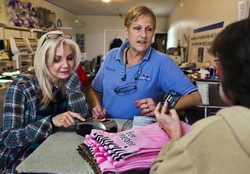New, microchipped credit cards are safer for consumers and could boost tourism and spending in Las Vegas, experts say, but are causing headaches for small-business owners, who must update their payment systems or face increased liability for fraud.
EMV — short for Europay, MasterCard and Visa — is a new standard for more secure credit card transactions in which chipped cards are accepted only by specific machines called EMV terminals.
For consumers, the change, introduced Oct. 1 in the United States, means people now must insert their credit card into a machine rather than swipe it and enter a pin code or provide a signature, depending on the cost of the purchase.
For businesses, however, the switch involves much more. All retailers except for those who own ATMs and gas stations now may be liable for fraudulent charges that occur if an EMV terminal is not used. ATM operators have until October 2016 and gas station proprietors have until October 2017 to adapt to the new standard.
Before the shift, credit card issuers typically assumed the cost of fraud. Now, if a business does not have an EMV terminal, credit card companies say the business owners likely would be responsible for fraudulent purchases.
The rationale is that business owners are being given the opportunity to use a safer system, and failing to do so would be their choice. (However, nonchipped cards would be the responsibility of the card issuer, not the business.)
The security changes come as credit card fraud in the United States grows at an alarming rate. The United States is one of the few remaining strongholds for credit-card fraudsters, as many countries in Europe and Asia, as well as Canada, already adopted EMV cards.
In 2013, the United States accounted for about half of all global payment fraud. Last year, the cost of credit card fraud nationwide grew by almost 30 percent to about $7 billion.
It’s a trend that hurts businesses. The Association of Certified Fraud Examiners found that in 2014, businesses lost about 5 percent of their revenue to fraud. The average loss amounted to $145,000.

Michele Walker of Imaginations Unlimited in Henderson uses the EMV system in her business where chips placed on credit cards on Tuesday, November 17, 2015. Photo by: L.E. Baskow
With EMV cards, each transaction is encrypted with a unique code. Add the extra layer of security from a pin code or signature, and fraud can be reduced significantly, proponents say.
“If you can do something to keep yourself a little safer, why wouldn’t you?” asked Beth Kitchener, a MasterCard spokeswoman.
Businesses, however, are encountering complications with the system.
Many consumers have yet to be issued a pin code. That means they still must swipe their cards instead of inserting them into an EMV terminal.
“Because they swiped it instead of EMV’d it, (the business) could be liable,” said Julio Rendon, vice president of operations at Las Vegas-based Cornerstone Merchant Services.
Additionally, some EMV terminals can’t accept chipped cards yet. Each type of machine has to be certified by credit card companies such as MasterCard before chipped cards can be processed. That takes time, as there are hundreds of credit card manufacturers that each produce hundreds of types of terminals.
“You have a lot of merchants right now who spent all this money to be compliant, and (the EMV terminals) don’t even work,” Rendon said. “That’s the biggest frustration.”
Cornerstone charges customers $295 for one EMV terminal. At Moneris Solutions, a Canadian credit card processing company, the least expensive terminals rent for about $20 per month.
The slow process of certifying EMV machines has been particularly troubling for restaurants, which rely on computer systems to complete transactions. Many businesses in the food industry have decided to wait until more EMV terminals have been certified before making the switch to EMV, Rendon said. But that leaves them open to liability.
“Restaurants don’t have a solution,” Rendon said. “Their computer systems just don’t accept the EMV technology. They have to redo their entire system.”
In Las Vegas, businesses could face increased risks because of the number of tourists who pass through here. Travelers who already have chipped cards may have no choice but to swipe their cards until more machines become active.
“You have this whole breed of consumers who are swiping their cards,” Rendon said. “They’re a liability.”
Kitchener said the best advice she can offer business owners is to explore their options. Rendon said the safest option for businesses is to be informed.

Summer Hershey presses buttons on the EMV system used by Michele Walker of Imaginations Unlimited in Henderson as friend Billie LeBoeuf talks to her about embroidering. Some businesses are having trouble adapting to the system where the chips placed on credit cards. Photo by: L.E. Baskow
“Call your merchant provider,” he said. “Talk with someone who understands this. And talk to a couple of different people because you will hear different stories.”
Although it will take time for the system to be smoothed over, Lester Romero, assistant vice president at Wells Fargo in Nevada, said the EMV system eventually could boost tourism and spending in Las Vegas.
“I think it opens up to more opportunities from customers from Europe,” Romero said.
Rob Cameron, chief product and marketing officer at Moneris, agreed.
“Tourists from all over the world arrive in (Las Vegas) every day,” he said. “The majority of these customers have chips on the cards and expect to be able to pay with them. The world has moved forward.”
Kitchener said she doesn’t expect businesses and customers to embrace the new system right away, but she believes that in the long run, the benefits are indisputable.
“It’s like any change,” she said. “It takes time.”
